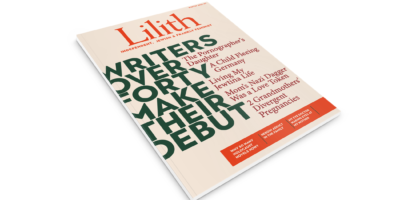
We Need to Talk About Bruno from The Boy in the Striped Pajamas
One of the best-selling Holocaust novels of the twenty-first century has sold over eleven million copies, was a mainstay on the New York Times Bestseller List, was made into a popular film, and is frequently assigned in U.S. schools—just to name a few of its accolades. The fact that publishing company Penguin Random House just released its highly anticipated sequel should be good news for anyone who believes that Holocaust education is key—right?
Not in this case. The books in question are John Boyne’s 2006 bestseller The Boy in the Striped Pajamas, which has been derided for its historical inaccuracies and empathetic portrayal of Nazis from no less a source than the Auschwitz Memorial Museum itself, and its just-released sequel All the Broken Places. These novels are maudlin Holocaust stories that paint Jewish suffering as less important that German morality. As a result, in a climate of increasing misinformation and white nationalism thanks to Kanye, Elon Musk and Donald Trump, these books won’t really help. In fact, they may hurt.
For anyone unfamiliar with the novel, The Boy in the Striped Pajamas is told from the perspective on nine-year-old Bruno, whose Nazi family moves into a house just outside of Auschwitz when his father becomes the ranking officer at the death camp. Bruno, who is completely ignorant of the world around him, befriends a Jewish boy named Shmuel who is imprisoned in Auschwitz. When Bruno sneaks into the camp with Shmuel, something his sister Gretel goads him into doing, both boys are rounded up and killed in the gas chambers.
As if the glaring historical inaccuracies aren’t enough, there are two additional ways in which Boy supports white nationalist ideologies such as Holocaust denial. First is the degree to which Jews and Jewish suffering are erased from the Holocaust narrative. Bruno frequently makes incorrect assumptions—which Shmuel never corrects—about what happens inside Auschwitz, skirting discussion of Nazi ideology. For instance, when Bruno claims that Germany “is superior” to other countries, “Shmuel stared at him but didn’t say anything.” Shmuel later tells Bruno “I don’t think the [Nazi] soldiers like us,” but when Bruno brings up his father’s role as a soldier, “Shmuel bit his lip and said nothing.” Shmuel’s father goes missing, but it is never explained that he has likely been killed. For those of us who have a firm understanding of this historical period, the implications are loaded, but they are never spelled out for young or uninformed readers.
One could argue—as Boyne has—that it is the responsibility of educators and caregivers to help students fill in the historical context. Unfortunately, the state of Holocaust education in America suggests that isn’t happening adequately.
According to a survey by the Claims Conference (a nonprofit organization that helps Holocaust victims, survivors, and their families receive reparations from the German government) 48% of respondents in the United States, all between 18–39 years old, could not name a single concentration camp or ghetto. When asked about the number of Jews murdered during the Holocaust, 63% did not know that over six million Jews were killed. Shockingly, 11% believed that Jews had caused the Holocaust, and 40% said they have seen Holocaust denial messaging on social media. While no hard data are available on how frequently Boy in the Striped Pajamas is assigned in U.S. classrooms, a 2016 survey from University College London’s Centre for Holocaust Education indicated that 35% of British teachers assigned this book to students, for many of whom it is their first exposure to Holocaust “education.”
A quick search of “Boy in the Striped Pajamas” and “American schools” reveals thousands of hits, most of which are related to lesson plans, activity guides, and other resources that support the notion that Boy is regularly assigned in American schools as well.
One can begin to see, then, how problems arise when kids read a Holocaust novel that is silent on Jewish suffering. There are no direct depictions of dead bodies, gas chambers, typhus, starvation, or ghettos. In fact, there is almost no violence and very little mention of Jews at all, since Judaism is a concept that little Bruno doesn’t understand. The novel flirts with the relationship between Jews and Nazis, but never crosses the line into outright explanation. For instance, when Bruno approaches his sister Gretel to help him understand why Shmuel is on one side of the fence and he on the other, she describes the two factions as “Jews” and “the Opposite.” “Well, why don’t we like them?” he asks. “Because they’re Jews,” she replies. “I see,” young Bruno muses, “and the Opposite and the Jews don’t get along.” Right at the moment Gretel attempts to further educate her brother, she finds lice in her hair, and the narrative is yanked in a different direction.
The University College London survey further revealed there is a second way in which Boy engages with white nationalist ideologies. The survey concluded that reading this book “regularly elicited profound and often somewhat misplaced sympathy for German and even Nazi families whom, students argued, The Boy in the Striped Pajamas helped them to see as ‘victims’ too.” To reiterate: the novel teaches kids to empathize with and humanize Nazis. To young readers who lack the historical context, the ending of the novel is not sad because over a million human lives—almost all of them Jewish—were brutally stolen at Auschwitz, nor it is sad because a lonely, scared Jewish boy named Shmuel dies. In the end, The Boy in the Striped Pajamas is sad because innocent Bruno, Nazi born and raised, dies.
Rather than evolving from the mistakes he made in Boy, Boyne—through the platform granted by his high-powered publishers—doubles down on these troubling themes in All the Broken Places. This sequel is told from the perspective of Gretel, in which she relates nearly 80 years of struggles that stem from her family’s Nazi past. While Gretel obviously struggles with her family’s role in Nazi atrocities, the emphasis is on how hard Gretel’s life is because of what her father did, not on the people whose lives he stole.
For instance, the only Jewish character in Broken Places is a man Gretel dates as a young woman; he eventually leaves her when he learns who her father was, which puts readers in the position of feeling sorry for poor Gretel. In fact, there are many situations in which readers are positioned to see Gretel as a victim in post-war Europe, where she faces retributive violence from angry Frenchmen who lost loved ones, discrimination over her German accent, and constant fear of Nazi hunters. In his Author’s Note, Boyne claims that “[he] is not trying to create a sympathetic character in Gretel,” but the constant emphasis on the ways in which her father’s Naziism ruins Gretel’s life makes it almost impossible to not feel sympathy toward her. In fact, most of adult Gretel’s suffering comes from the guilt she feels from her part in her brother Bruno’s death, which orients the narrative’s central tragedy toward the death of a single German boy instead of to the horrors of the Shoah.
Additionally, Gretel is not immune to feeling nostalgic for her genteel life under the Reich, and even indulges in Nazi nostalgia. For instance, when a former Nazi lieutenant crosses Gretel’s path, he shows her a pair of Hitler’s eyeglasses that he carries with him decades after the war. “I felt disgusted to be holding them and, to my intense shame, privileged. Could I wear them,” Gretel wonders, “Did I dare? A moment later, they were on my face and a sound, a sigh of pleasure or a groan of dismay, emerged from my mouth.” Boyne no doubt thinks that Gretel’s paradoxical reaction makes her a complex character, but the fetishization of Hitler’s glasses is disturbing to anyone with a healthy fear of Nazism in our own time. So too is the fact that, in the end, Gretel is the hero of the novel, saving her nine-year old neighbor boy from his abusive father; symbolically redeeming herself from encouraging young Bruno to sneak into Auschwitz all those years ago.
Only time will tell if All the Broken Places will reach the same level of success as Boy, but its publication puts Boyne’s Holocaust misinformation back in the public eye at a time when sympathy for Nazi-like ideology is at its highest in years. It is just one cog in the machine that is white nationalism, but each time publishers and educators uncritically amplify its dangerous message while suppressing the truths told by survivors, our world feels a little bit more dangerous.
Leah Grisham, Ph.D., is a freelance writer and book critic; her first book, Heroic Disobedience, is forthcoming from Vernon Press.



